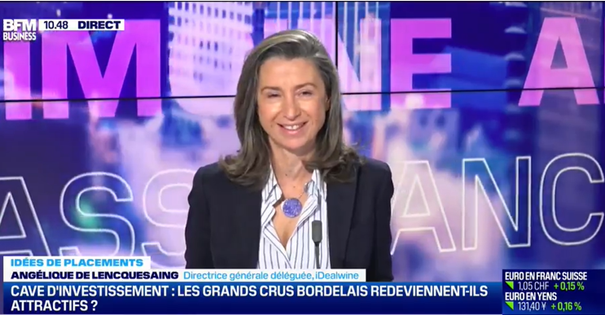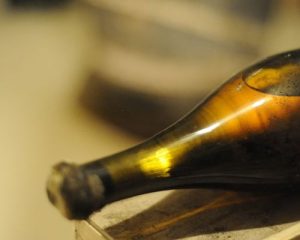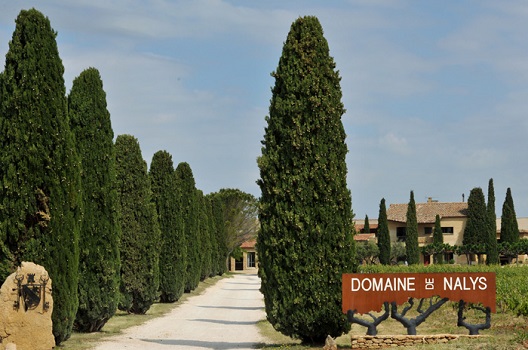
This time, Angélique de Lencquesaing took her spot on BFM’s investment segment to talk about starting a cellar.
Stéphane Pedrazzi: The new year brings a chance for new projects. And investing in wine might well be an idea that’s caught your attention. Angélique de Lencquesaing, through your analysis of iDealwine’s results, you observed an increasing appetite for fine wine in 2021.
Angélique de Lencquesaing: Yes, putting together an investment cellar is a great project, and to do that, it’s best to look at how the market is evolving, which are the record-breaking bottles, where is the demand etc. And it’s true that 2021 was a record year for wine in many ways.
Record for sales, prices, or both?
Yes, both actually! iDealwine held no less than 48 auctions throughout the year, including nine dedicated to private collections. As well as these wine sales, we should add the six spirits auctions that took place on Fine Spirits Auction.
Sales records were recorded all over the place in the second half of 2021, both in France and beyond. Looking at France, we can’t ignore what happened at the Hospices de Beaune, when the charity barrel – 288 litres of Corton Renardes – sold for €800k. In the same week in November, iDealwine saw a new record set for a jeroboam of 2006 Echézeaux from Domaine Bizot, equivalent to four bottles, that went under the hammer for €41,752.
So this buying fever has caught hold of the fine wine market?
Well, in our auctions we saw an 8.5% increase in the number of bottles sold last year. In value, there was a leap of +19.5%. The price effect magnified as the months went on.
You mentioned the phenomenon of wine as an investment. It’s more and more striking to see the extent to which wine is becoming an asset in its own right. Certain bottles, certain names are attracting the attention of buyers, and these are the cuvées that have seen an explosion in value over recent months.
The phenomenon doesn’t affect wines from every region, then?
Burgundy is the most highly coveted region of them all. When we look at the top 50 highest bids on our site from last year, Burgundy lots take up 40 places. Even more impressive, when we look at the figures for the top 50 individual bottles, the region occupies 49 places!
Making the highest priced bottle of the year a Burgundy grand cru?
That’s right, it was a 2006 Musigny from Domaine Leroy, which sold for €28,244. This result illustrates the acceleration of the market, as 2020 saw a 2001 vintage from the same domain sell for €17,499, the top hammer price that year. That makes for a 61% increase in one year for a comparable vintage.
Is Bordeaux disappearing from the rankings?
Not entirely! Wines from this region have held onto ten places in the table of top 50 lots. The most successful ones often come in cases of several bottles; either one cru (Cheval Blanc, Petrus, Mouton Rothschild) or mixed cases. For example, a ‘Carré d’As’ case that contained 16 bottles of Petrus, Margaux, Latour, and Haut-Brion in their 2000 vintages went under the hammer for €27,016.
However, it’s true that Bordeaux doesn’t feature at all this year in our ranking of the top 50 most expensive individual bottles.
From an investment point of view, is Bordeaux an attractive region?
When compared with the soaring prices we’ve seen for some Burgundy wines, it’s definitely worth considering Bordeaux bottles as an investment. They come with two main advantages.
Firstly, fine Bordeaux wines are cellaring wines; they’re made to last. This makes them an easy investment purchase, especially as they stay at their peak for a long time. They’re quite a safe bet in this sense.
Secondly, they enjoy global renown. There are still plenty of Bordeaux buyers, ensuring dynamism on the secondary market.
You say ‘still’, do you think this might not last?
Bordeaux is still successful with a very classic kind of consumer, so it’ll have to update its image a bit to attract younger wine enthusiasts. Otherwise, people will start putting together cellars without ticking the Bordeaux box, as has been the case for decades now.
To be honest, the fact that we now find fine wine in every region plays a big part in this evolution.
For someone wishing to create an investment cellar, then, which wine regions should they turn to?
There’s really no priority when it comes to these initial choices, a new and quite radical change compared with how the market used to be. 20 years ago, the order of play was simple: investing in Bordeaux came first, followed by Burgundy, then a few wines from the Rhône and some fizz from Champagne.
Nowadays, there’s a lot more on the table, and it’s much more important to base your decisions on the qualities of a wine grower, a name, an estate. Each region has its own emblematic names that lead the way for their appellation. Another top tip is to follow guides and professional tasters to see which bottles come from promising estates.
But do these wines from lesser-known appellations sell well?
The top trio of Burgundy, Bordeaux, and the Rhône certainly still take the lion’s share of auction success. However, there are plenty of domains from other regions now giving the classics a run for their money. It’s no coincidence that the only non-Burgundian bottle in our top 50 was a wine from the Languedoc, the first vintage made by the late Laurent Vaillé. The 1992 from his Grange des Pères estate sold for €8,350 in December 2021.
Do you have any recommendations to get us going?
There are three main ideas to keep in mind:
Take stock of what you like. It’s absolutely essential to buy wines that you think you’d love to uncork someday. Even if you’re putting together your cellar as an investment, following your own tastes will push you to buy the best for your collection.
Depending on the chosen region, look into the vintages and choose those that will age well. You know when you’re buying, but you don’t know when you might be selling the wine on. Opt for bottles with a medium ageing potential, around 8-10 years is a good place to start.
Get reading, talking, analysing…find out everything you can about the wine market, its trends, evolutions, and where it might be going. Keep an eye out for estates to follow and upcoming names. Investing in wine is anything but a rookie’s game.
With these bits of advice in mind, if the payback isn’t what you’d hoped for, you should still have plenty to celebrate when you uncork your wonderful purchases…
Interested in selling some bottles? Find out more



